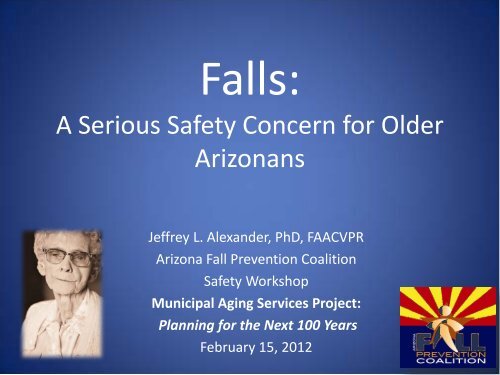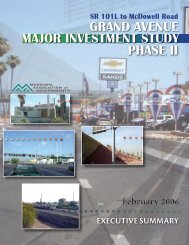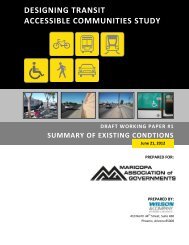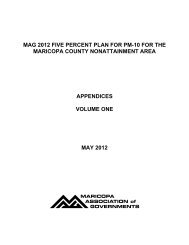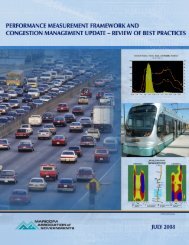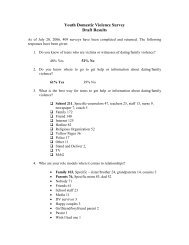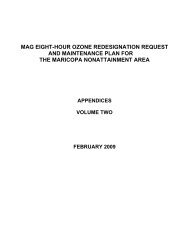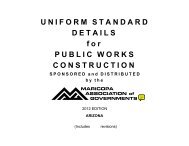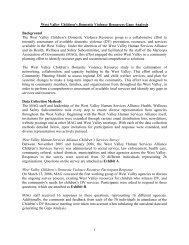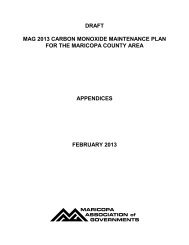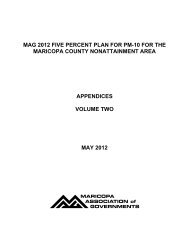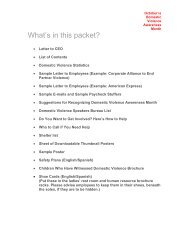Falls A Serious Safety Concern for Older Arizonans - Maricopa ...
Falls A Serious Safety Concern for Older Arizonans - Maricopa ...
Falls A Serious Safety Concern for Older Arizonans - Maricopa ...
Create successful ePaper yourself
Turn your PDF publications into a flip-book with our unique Google optimized e-Paper software.
<strong>Falls</strong>:<br />
A <strong>Serious</strong> <strong>Safety</strong> <strong>Concern</strong> <strong>for</strong> <strong>Older</strong><br />
<strong>Arizonans</strong><br />
Jeffrey L. Alexander, PhD, FAACVPR<br />
Arizona Fall Prevention Coalition<br />
<strong>Safety</strong> Workshop<br />
Municipal Aging Services Project:<br />
Planning <strong>for</strong> the Next 100 Years<br />
February 15, 2012
Arizona Fall Prevention Coalition<br />
• Born in late 2008 out of the Governor’s Office<br />
on Aging<br />
• Funded by a grant from the Virginia G. Piper<br />
Charitable Trust.<br />
• Now coordinated by the Area Agency on<br />
Aging, Region One
Arizona Fall Prevention Coalition<br />
• 70 members from local professionals<br />
dedicated to reducing the risk of falls by older<br />
<strong>Arizonans</strong> through education, awareness, and<br />
outreach
Arizona Fall Prevention Coalition<br />
• Mission<br />
– The mission of the AZ Fall Prevention Coalition is<br />
to reduce the risk of falls by older <strong>Arizonans</strong><br />
through education, awareness, and outreach<br />
focused on three essentials of fall prevention:<br />
medication management, physical activity, and<br />
home and environment modification.<br />
• More info at: www.azstopfalls.org
Objectives<br />
• Discuss the significance of the problem<br />
• Primary risk factors associated with falls<br />
• Key fall prevention strategies<br />
– Physical activity<br />
– Medication management<br />
– Home modification<br />
• Discuss national and local community<br />
resources
Magnitude of the Problem
Magnitude of the Problem<br />
• One out of three adults age 65 and older falls<br />
each year. 1,2<br />
• Among older adults (those 65 or older), falls are<br />
the leading cause of injury death. They are also<br />
the most common cause of nonfatal injuries and<br />
hospital admissions <strong>for</strong> trauma. 3<br />
• In 2008, over 19,700 older adults died from<br />
unintentional fall injuries. 3
Magnitude of the Problem<br />
• The death rates from falls among older men and<br />
women have risen sharply over the past decade. 4<br />
• In 2009, 2.2 million nonfatal fall injuries among<br />
older adults were treated in EDs and more than<br />
581,000 of these patients were hospitalized. 3<br />
• In 2000, direct medical costs of falls totaled a<br />
little over $19 billion—$179 million <strong>for</strong> fatal falls<br />
and $19 billion <strong>for</strong> nonfatal fall injuries. 5
No Small Problem in Arizona<br />
• In 2007, Arizona ranked 8th in the nation <strong>for</strong> unintentional<br />
fall-related deaths among adults age 65 years and older. 6<br />
• In 2010, falls accounted <strong>for</strong> 71 percent of unintentional<br />
injury deaths among older adult residents of <strong>Maricopa</strong><br />
County (n=449).<br />
• 6,622 inpatient hospitalizations and 14,670 emergency<br />
department visits due to non-fatal unintentional fallrelated<br />
injuries among older adult residents<br />
of <strong>Maricopa</strong> County.
No Small Problem in Arizona
Risk Factors <strong>for</strong> <strong>Falls</strong>
Risk Factors <strong>for</strong> <strong>Falls</strong> – Intrinsic 7,8<br />
• Muscle weakness, particularly in the legs<br />
• Poor balance and difficulty walking<br />
• Postural hypotension or drop in blood<br />
pressure with change in position<br />
(lightheadedness, dizziness)
Risk Factors <strong>for</strong> <strong>Falls</strong> – Intrinsic 7,8<br />
• Vision problems (e.g. poor depth<br />
perception, cataracts, glaucoma,<br />
adjusting from light to dark environment)<br />
• Slowed reflexes/reaction time<br />
• Sensory problems<br />
• Confusion
Risk Factors <strong>for</strong> <strong>Falls</strong> – Extrinsic 7,8<br />
• Environmental hazards<br />
– Poor lighting<br />
– Poorly maintained walkways (e.g. cracks in<br />
sidewalk)<br />
– Slick surfaces (e.g. flooring, ice, water)<br />
– Loose rugs<br />
– Clutter<br />
– No stair railings<br />
– No grab bars in shower<br />
More than half of falls<br />
occur in the home
Risk Factors <strong>for</strong> <strong>Falls</strong> – Extrinsic 7,8<br />
• Poor footwear (e.g. flip flops, leather soles,<br />
high heels)<br />
• Multiple prescription medicines<br />
– Four or more increases risk <strong>for</strong> falls
Risk Factors <strong>for</strong> <strong>Falls</strong> – Extrinsic 7<br />
• Drugs that may increase risk<br />
– Sedative-hypnotic and anxiolytic drugs (especially longacting<br />
benzodiazepines)<br />
– Tricyclic antidepressants/anti-psychotics<br />
– Major tranquilizers (phenothiazines and butyrophenones)<br />
– Antihypertensive drugs<br />
– Cardiac medications<br />
– Corticosteroids<br />
– Nonsteroidal anti-inflammatory drugs<br />
– Anticholinergic drugs<br />
– Hypoglycemic agents<br />
– Any medication that is likely to affect balance
Key Fall Prevention Strategies<br />
Physical Activity<br />
Medication Management<br />
Home Modification
Physical Activity<br />
• “Regular physical activity is a first line of<br />
defense against falls…” 8<br />
• Consistent, regular physical activity will<br />
improve:<br />
– Muscular strength<br />
– Balance<br />
– Coordination<br />
– Stamina<br />
– Flexibility
Physical Activity<br />
• A regular physical activity program should<br />
consist of the following types of exercise:<br />
– Strength (e.g. resistance or weight lifting)<br />
– Flexibility (e.g. static and dynamic stretching)<br />
– Aerobic/endurance/general conditioning (e.g.<br />
walking)<br />
– Balance (e.g. static and dynamic)<br />
– Meditation (e.g. Tai Chi, Yoga)
Medication Management 9<br />
• For some people, different medications can<br />
lead to drowsiness, dizziness or feeling<br />
lightheaded; all of which can affect balance<br />
and increase risk of falling.<br />
• Multiple (four or more) medications can lead<br />
to an increased risk <strong>for</strong> falls
Medication Management 9<br />
• <strong>Older</strong> adults should talk with pharmacist or<br />
doctor about possible side effects, to<br />
determine how one can best limit risk of a fall<br />
related injury.<br />
• Request a “brown-bag check-up”<br />
– Gather all of current medications and over-thecounter<br />
products into a "brown-bag" and show<br />
them to doctor or pharmacist so he/she<br />
can look <strong>for</strong> any potential problems.
Home Modification 9<br />
• Home Modifications are a critical part of<br />
ensuring older adults’ safety from falls.<br />
• Simple and easy such as removing rugs that<br />
one is tripping on or plugging in a night light<br />
• More extensive and costly such as installing<br />
grab bars in the shower or stair railing<br />
• Several resources are provided under the<br />
“Home Modification” section of the<br />
AZFPC website
Resources
National Resources<br />
• Centers <strong>for</strong> Disease Control and Prevention (CDC) – “Focus on<br />
Preventing <strong>Falls</strong>”<br />
(http://www.cdc.gov/Features/<strong>Older</strong>Americans/)<br />
• CDC , Injury Prevention and Control, Home and Recreational<br />
<strong>Safety</strong>, “<strong>Falls</strong> – <strong>Older</strong> Adults”<br />
(http://www.cdc.gov/HomeandRecreational<strong>Safety</strong>/<strong>Falls</strong>)<br />
• NIH Senior Health, “<strong>Falls</strong> and <strong>Older</strong> Adults”<br />
(http://nihseniorhealth.gov/falls/toc.html)<br />
• National <strong>Safety</strong> Council, “Protecting Ourselves from Slips, Trip,<br />
and <strong>Falls</strong>”<br />
(http://www.nsc.org/safety_home/Resources/Pages/<strong>Falls</strong>.aspx)
Local Resources<br />
• Arizona Fall Prevention Coalition (AZFPC)<br />
• Evidence-based fall prevention programs<br />
– A Matter of Balance: Managing <strong>Concern</strong>s About<br />
<strong>Falls</strong>, offered in various community centers and<br />
organizations in <strong>Maricopa</strong> County<br />
• Annual National <strong>Falls</strong> Prevention Awareness Day<br />
hosted by the AZFPC (1 st day of Fall)<br />
• Rebuilding Together, Valley of the Sun, Senior Fall<br />
Prevention Services<br />
(http://www.rebuildingtogetherphx.org/programsevents/sfps/)<br />
480.774.0237
References<br />
1. Hausdorff JM, Rios DA, Edelber HK. Gait variability and fall risk in<br />
community–living older adults: a 1–year prospective study. Archives of<br />
Physical Medicine and Rehabilitation 2001;82(8):1050–6.<br />
2. Hornbrook MC, Stevens VJ, Wingfield DJ, Hollis JF, Greenlick MR, Ory<br />
MG. Preventing falls among community–dwelling older persons: results<br />
from a randomized trial. The Gerontologist 1994:34(1):16–23.<br />
3. Centers <strong>for</strong> Disease Control and Prevention, National Center <strong>for</strong> Injury<br />
Prevention and Control. Web–based Injury Statistics Query and<br />
Reporting System (WISQARS) [online]. Accessed November 30, 2010.<br />
4. Stevens JA. Fatalities and injuries from falls among older adults – United<br />
States, 1993–2003 and 2001–2005. MMWR 2006a;55(45).<br />
5. Stevens JA, Corso PS, Finkelstein EA, Miller TR. The costs of fatal and<br />
nonfatal falls among older adults. Injury Prevention 2006b;12:290–5.
References<br />
6. Centers <strong>for</strong> Disease Control and Prevention, National Centers <strong>for</strong> Injury<br />
Prevention and Control. Web-based Injury Statistics Query and Reporting<br />
System (WISQARS) [online]. (2007). Available from URL:<br />
www.cdc.gov/ncicp/wisqars.<br />
7. Fuller, G.F. (2000). <strong>Falls</strong> in the elderly. American Family Physician, 61(7):<br />
2159-2168.<br />
8. NIH Senior Health. <strong>Falls</strong> and <strong>Older</strong> Adults [online]. Accessed February 7,<br />
2012.<br />
9. Arizona <strong>Falls</strong> Prevention Coalition website. Available from URL:<br />
www.azstopfalls.org
Thank you!


